Netherlands is a small country on the North Sea in northwestern Europe. It is bordered by Belgium and Germany. The Netherlands is often called Holland, but this name officially refers only to the western part of the country. The people of the Netherlands call themselves Nederlanders. They are also known as the Dutch.

“God created the world, but the Dutch created Holland,” according to an old Dutch saying. More than two-fifths of the country’s land was once covered by the sea, or by lakes or swamps. The Dutch “created” this land by pumping out the water. These drained areas, called polders, became some of the richest farmlands of the Netherlands.
To make a polder, the Dutch build a dike around the area to be drained of water. The water is then pumped into a series of drainage canals. Windmills were once used to run the pumps, but electric motors have replaced most of them. Most polders are below sea level, and they collect excess water through seepage. As a result, pumping must continue after the polders are built.
The Zuider Zee << ZY duhr ZAY >>, once a large inlet of the North Sea, was cut off from the sea in 1932 by a dike 20 miles (32 kilometers) long. This development changed the Zuider Zee into a freshwater lake called the IJsselmeer << Y suhl `mehr` >>. Much of the lake was then drained to make several large polders. This project added 637 square miles (1,650 square kilometers) of land for new farms and cities. The Netherlands gained an entire new province, Flevoland << FLEE voh lahnt >>.
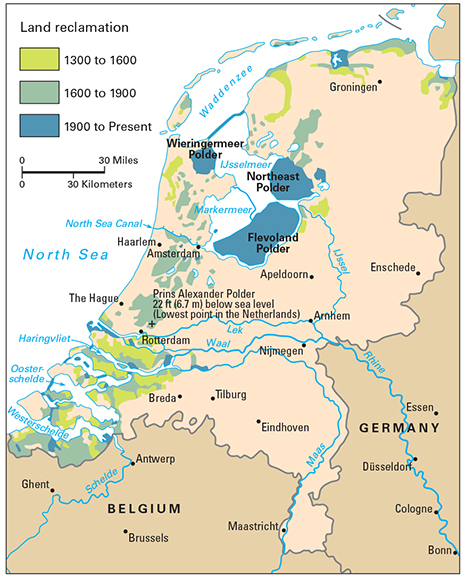
The people of the Netherlands have great pride in their long battle against the sea. Because their country is one of the most densely populated countries in the world, they take extreme care to protect their hard-won land and to plan wisely the use of every acre. Several times during their history, however, the Dutch have opened the dikes and flooded the land to save their country from invaders. 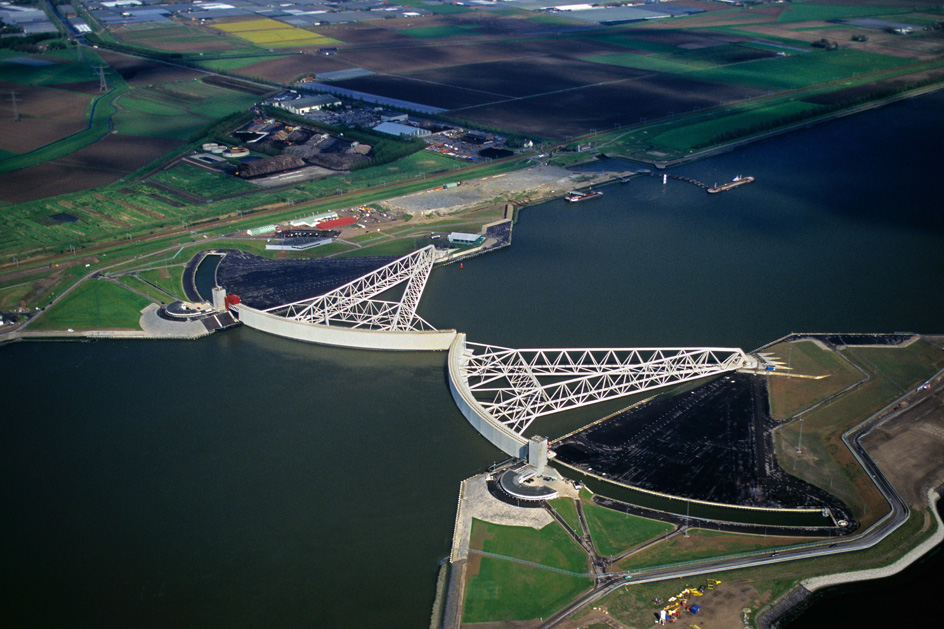
Most of the Netherlands is flat, though it has some uplands. Many canals cut through the country. They not only drain the land but also serve as waterways.
Dairy farming is the most important form of agriculture in the Netherlands. The processing of dairy products is a major branch of Dutch manufacturing.
The country’s rulers have included the Romans, a Germanic people called the Franks, the Spanish, and the French. The Dutch declared independence from Spain in 1581, and Spain recognized their independence in 1648. In 1815, the Netherlands became an independent kingdom united with Belgium. The two countries separated in 1830, when Belgium declared its independence.
The Dutch experienced a period of great prosperity and power—a Golden Age—during the 1600’s. At that time, the country was the world’s leading sea power, and it ruled a great colonial empire. Amsterdam was an important trading center, and Dutch businesses thrived. The Golden Age was also a time of cultural achievement, especially in painting.
Government
The Netherlands is a constitutional monarchy. It has a democratic government that is based on a constitution. Citizens aged 18 and older may vote.
National government.
A king or queen is the country’s head of state, but the monarch’s duties are mostly ceremonial. The monarch signs all bills that are passed by the parliament and appoints government officials upon the advice of various government bodies.
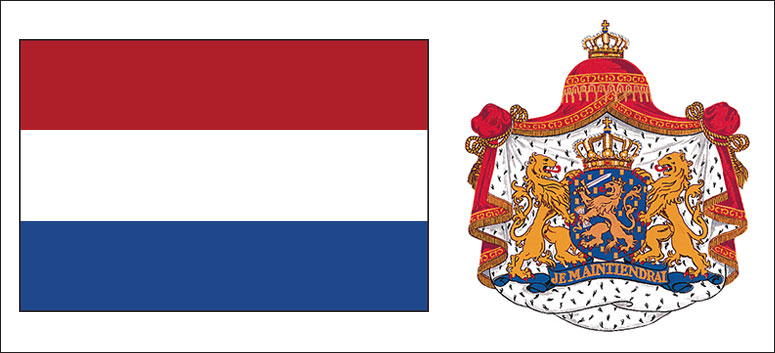
Netherlands national anthem
Dutch monarchs, unlike those of other countries, are not crowned. Instead, they go through a ceremony called investiture, in which power is given to them by the people. This practice is based on a medieval tradition. In the Middle Ages, new leaders traveled from town to town in their realm. They asked for oaths of allegiance from local authorities and, in return, promised to respect the rights of the townspeople. The investiture takes place in Amsterdam, the official capital. Another city, The Hague << hayg >>, is the seat of government.
A prime minister, appointed by the monarch, heads the government. The prime minister selects members of a Cabinet to run the government departments. Cabinet members remain in office as long as they have the support of parliament. If parliament formally withdraws its support from individual ministers or the Cabinet as a whole, the individual ministers or the Cabinet as a whole are required to resign.
The parliament of the Netherlands, the States-General, consists of two houses. The First Chamber has 75 members, who are elected to four-year terms by the legislatures of the country’s provinces. The Second Chamber proposes new laws. It has 150 members, who are elected to four-year terms by the people. The members are chosen under a system called proportional representation. This system gives each political party a share of seats in the Second Chamber according to its share of the total votes cast.
Local government.
The Netherlands is divided into 12 provinces, each governed by a commissioner and a council. The monarch appoints the commissioner. Council members are elected by the people to four-year terms. The number of council members varies according to population. The provinces are made up of municipalities. Each municipality has an elected council and an executive called a burgomaster, who is appointed by the monarch.
Politics.
The largest political parties include the left-wing Dutch Labor and Socialist parties, a centrist party called the Christian Democratic Appeal, and the right-wing People’s Party for Freedom and Democracy (also called the Liberal Party). There are also many small parties. No party has held a majority of seats in the Second Chamber since 1945, when World War II ended. Therefore, all governments are formed by party coalitions (partnerships).
Courts.
The court system in the Netherlands consists of subdistrict courts, district courts, courts of appeal, and the Supreme Court. The monarch appoints all judges.
Armed forces.
The Netherlands has an army, a navy, and an air force. All the men and women in the armed forces serve on a voluntary basis.
The Kingdom of the Netherlands.
The kingdom also includes several islands in the Caribbean Sea. The islands of Aruba, Curaçao, and St. Martin (St. Maarten) are self-governing countries. All three have an appointed governor and a Council of Ministers headed by a prime minister. Three smaller Caribbean islands—Bonaire, Saba, and St. Eustatius—are overseas municipalities, with a status similar to that of towns in the Netherlands. Each Council of Ministers is responsible to a one-house legislature, whose members are elected by the islanders.
People
About 40 percent of the people of the Netherlands live in two coastal provinces—North Holland and South Holland. In these provinces are the three largest municipalities—Amsterdam, Rotterdam, and The Hague.
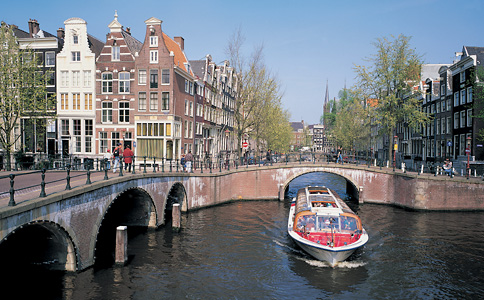
Ancestry.
Most of the people in the Netherlands are of Dutch ancestry. The largest non-Dutch groups in the country include people from Indonesia, Morocco, Suriname, and Turkey.
Language.
Dutch is the official language of the Netherlands. The Dutch language belongs to the Germanic language group. The people of the northern province of Friesland << FREEZ lahnt >> speak Frisian << FRIHZH uhn >>, another Germanic language. Most people of the Netherlands also speak English, and many speak French or German as well.
Way of life
The Netherlands is one of the most densely populated countries in the world. Nearly half of this small country lies below sea level, so the Dutch must carry on a continuous battle against the sea. Life in this environment has given the Dutch a practical, matter-of-fact outlook. To make the best use of their limited land and avoid overcrowding, the Dutch have developed a highly organized society. Neatness and self-control are prized. The Dutch tend to frown on extravagance and displays of wealth.
Although public life in the Netherlands is highly organized, there is a great deal of freedom in private life. The Dutch value personal privacy. They are also known for their good fellowship, called gezelligheid << guh ZEHL ihk hyt >>. This cozy friendliness among close friends and relatives is most frequently found at gatherings celebrating such occasions as birthdays and anniversaries. The Dutch are also interested in foreign countries, and many of them travel and work outside the Netherlands.
City life.
For centuries, the Netherlands has been one of Europe’s most urbanized regions. Nearly all Dutch cities were founded in the Middle Ages. The historic centers of these cities still have many shops and business and government offices. Public transportation is readily available, including subways and streetcars in the large cities.
Most city dwellers live in modern apartments and row houses. Because of high land prices, the cities have few single-family houses. The older residential sections of the major cities house many immigrants as well as university students and young adults.
Rural life.
Because every region of the Netherlands has several cities, few rural areas are truly remote. Farms are commercial businesses, and rural life is not too different from life in the towns. Most villages are accessible by water and are well provided with services and public transportation.
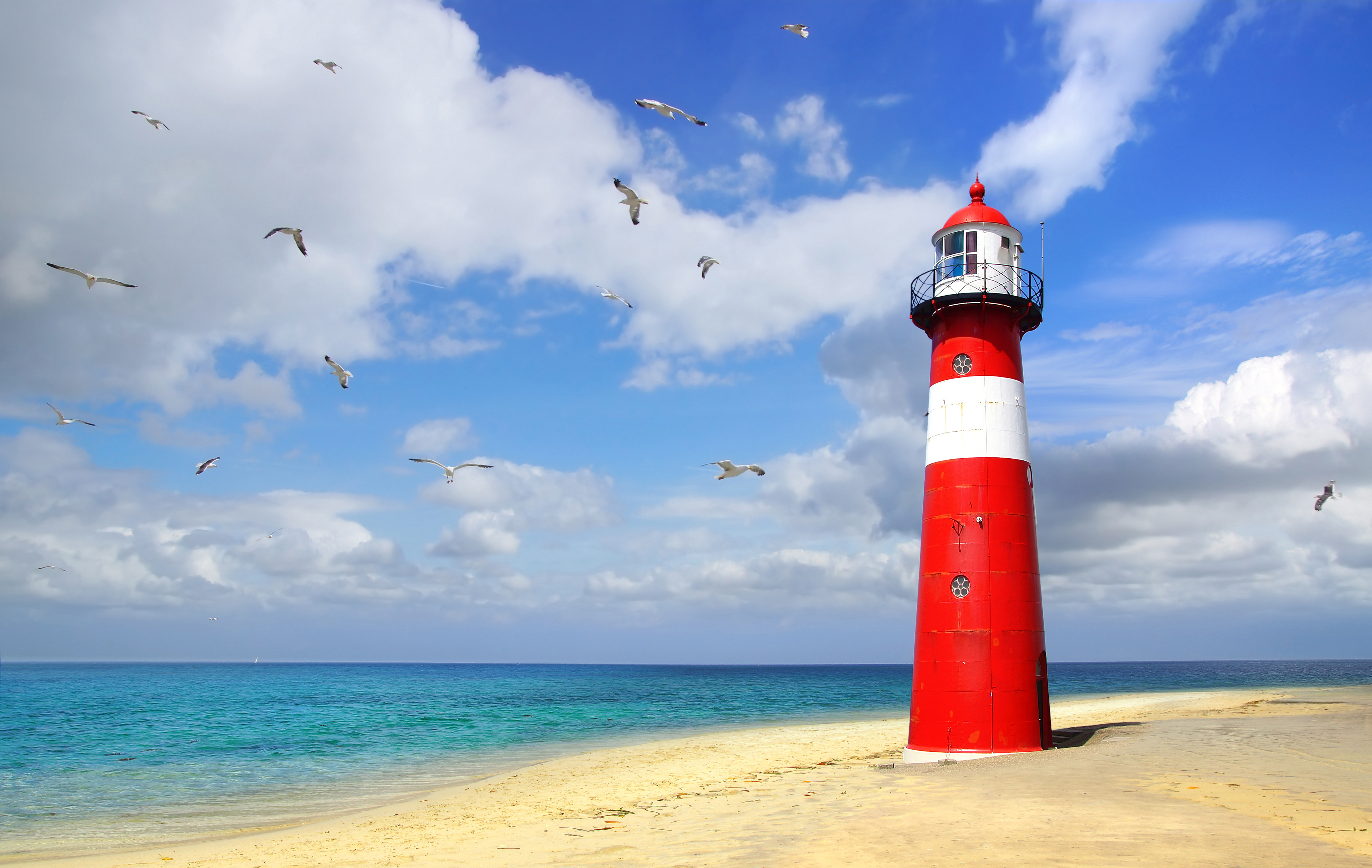
People in farm areas and fishing villages sometimes wear the famous Dutch wooden shoes, called klompen << KLOMP uhn >>. These shoes are noisy, but they protect the feet from damp earth better than leather shoes do. The Dutch do not wear wooden shoes in their homes. They leave them outside and change to leather shoes.
In a few rural areas, the people still wear the traditional Dutch costume, which includes full trousers for men and full skirts and lace caps for women. These areas include the islands of the province of Zeeland << ZAY lahnt >>, coastal fishing communities, and the towns of Staphorst << STAHP hawrst >> and Spakenburg << SPAH kuhn burk >>.
Food and drink.
The Dutch diet is similar to that of other northern European countries. Breakfasts often consist of bread, cheese, and cold meat. Most people eat a light lunch of a sandwich or salad. Most dinners include meat or fish, potatoes, and vegetables. Indonesian food is also popular. Traditional dishes include hutspot << HUTS pot >> (a stew of meat, vegetables, and potatoes); raw herring sprinkled with onions; and large, thin pancakes covered with toppings. Beer and jenever << yuh NAY fur >> (a juniper-flavored gin) are popular alcoholic drinks.
Holidays and recreation.
Most people in the Netherlands own a bicycle, and bicycle riding is a popular recreational activity. The Dutch also enjoy boating, sailing, and windsurfing on their many lakes, rivers, and canals. Miles of sandy beaches along the North Sea coast provide many places to swim. 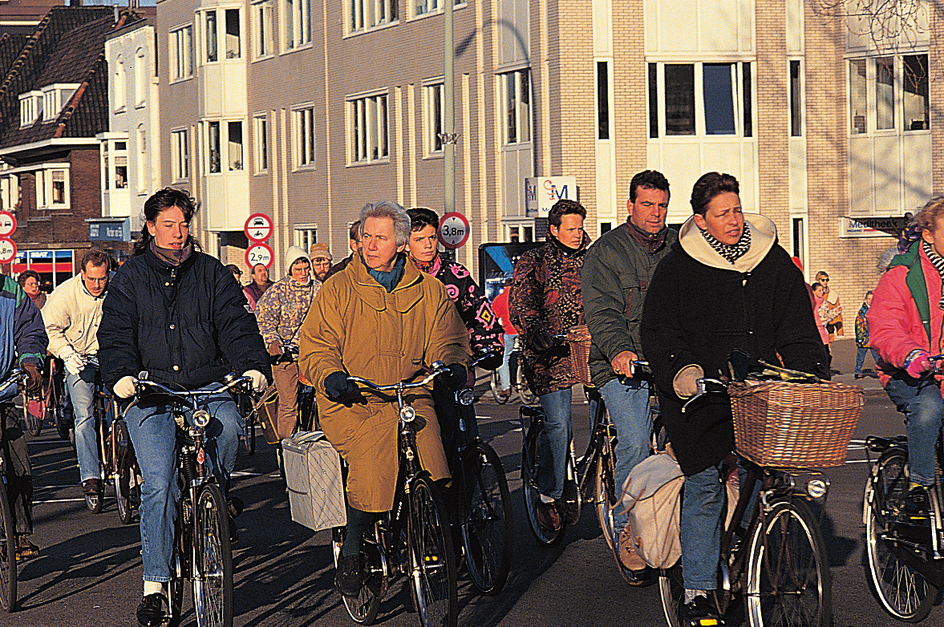
Ice skating is extremely popular. But the Netherlands has mild winters, and the ice often does not get thick enough for skating. When the ice is hard enough, schools sometimes close to let the children skate. In exceptionally cold winters, an ice-skating race called the Elfstedentocht << ehlf STEHD uhn tokt >> takes place on the waterways of Friesland. The 124-mile (200-kilometer) course connects 11 cities of the northern province.
Every community has sport clubs that organize team sports for youths and adults. The most popular sports include field hockey, soccer, and tennis.
The Netherlands is the world’s largest flower exporter, and Nederlanders are famous for raising tulips and other flowers. They hold many spectacular flower festivals each spring. Long parades of floats covered with blue, pink, red, and yellow blossoms wind through the towns near the bulb fields. Homes along the way are also decorated with beautiful floral designs.
The Dutch celebrate King’s Day, the birthday of King Willem-Alexander, on April 27 with local parades, games, and flea markets. Most towns hold a fair called a kermis << KEHR mihs >> with carnival attractions and other entertainment. 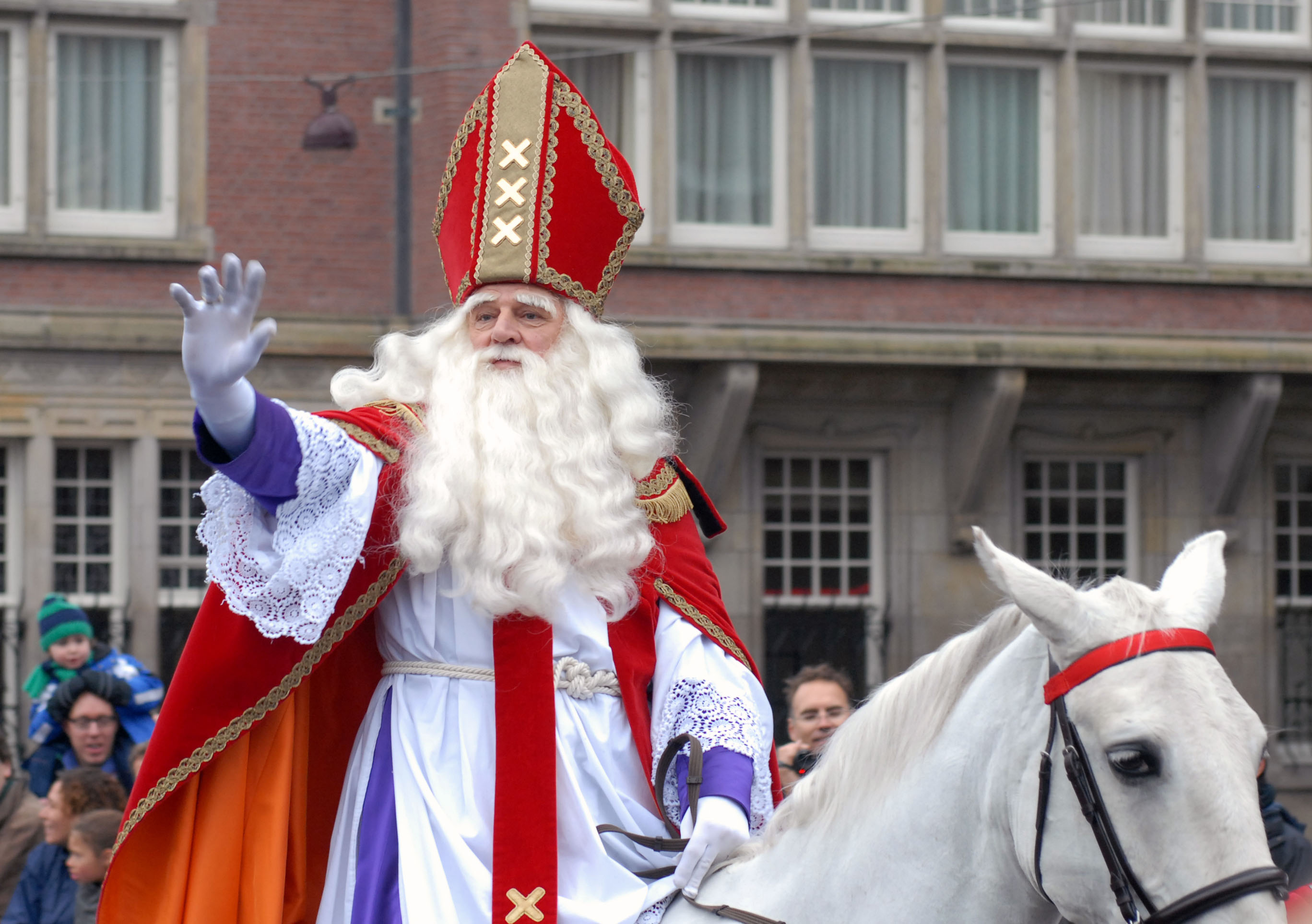
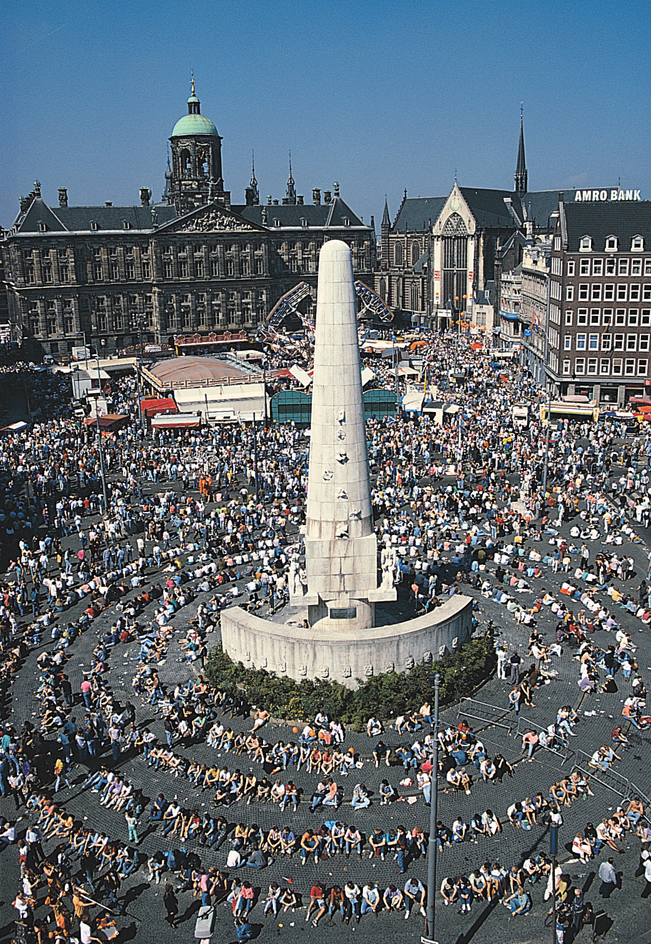
The Dutch exchange gifts on St. Nicholas’s Eve, December 5, instead of on Christmas. The children believe that Saint Nicholas visits their homes with presents for good boys and girls. A man dressed like a bishop represents Saint Nicholas and rides through the streets on a white horse. In Amsterdam, he arrives by steamship and is greeted by ringing bells and cheering crowds.
During the 1600’s, the Dutch brought the custom of Saint Nicholas’s visit with them to America. There, the English settlers changed his Dutch nickname, Sinterklaas, to Santa Claus.
Religion.
Roman Catholics make up about 30 percent of the Dutch population. About 20 percent of the people are Protestants, most of whom belong to the Protestant Church in the Netherlands. Members of the royal family traditionally belong to this church, but it is not an official state church. Muslims make up about 5 percent of the population. About 40 percent of the Dutch do not practice any religion.
Education.
Dutch law requires children from ages 5 through 16 to go to school. All schools that meet national educational standards, including religious schools, receive government funds. The standards, set by law, include courses of study and hiring of teachers. Almost all adults can read and write.
The Netherlands has no general high school program. Instead, it has several kinds of high schools. Each kind trains students for a special purpose, such as university work, advanced study in various institutes, or jobs in business or industry.
The Netherlands has several universities and many specialized institutions of higher education. Leiden University, founded in 1575, is the country’s oldest university. The University of Amsterdam, the University of Groningen, and Utrecht University—all founded in the 1600’s—are among the largest universities. The Open University, based in Heerlen, also has a large number of students. Founded in 1984, it carries out most of its instruction over the Internet.
Arts.
The Netherlands has produced some of the world’s greatest painters. During the 1600’s, the country’s Golden Age, the northern Netherlands was a republic. Without a royal court to order works of art, Dutch artists had to sell their creations to the country’s prosperous bankers, merchants, and traders. Dutch buyers looked for small paintings suitable for private homes, rather than large-scale religious works, so Dutch artists often painted ordinary people and things. Frans Hals became a master painter of portraits. Pieter de Hooch << PEE tuhr duh HOHK >> and Jan Vermeer << yahn vuhr MEER >> often painted indoor scenes, and Jacob van Ruisdael << YAH kawp vahn ROYS dahl >> specialized in landscapes. Rembrandt painted masterpieces on many subjects.
Later Dutch painters include Vincent van Gogh and Piet Mondrian. Van Gogh, who painted in the late 1800’s, is one of the most famous painters in modern art. Mondrian, who developed his extremely simplified geometric style of painting in the early 1900’s, influenced modern architecture and commercial design as well as painting. Many museums in the Netherlands exhibit the works of the great Dutch artists. Among them are the Rijksmuseum and Stedelijk Museum in Amsterdam and the Gemeentemuseum in The Hague.
The Dutch enjoy reading and support many writers. But Dutch literature is little known outside the Netherlands, and few works have been translated. One of the most important Dutch writers is Joost van den Vondel << YOHST vahn dehn VON duhl >>, a celebrated poet and playwright of the Golden Age. Constantijn Huygens << KON stuhn `tyn` HY `guhnz` >>, another figure of the Golden Age, produced witty, elegant verse.
Other important writers include Willem Bilderdijk << VIHL uhm `bihl` duhr DYK >>, Multatuli << `mul` tuh TOO lee >>, and Louis Couperus << loo EE koo PAY ruhs >>. Bilderdijk, a poet of the late 1700’s and early 1800’s, foreshadowed the Romantic era. Multatuli, the pen name of Eduard Douwes Dekker, was the author of Max Havelaar (1860), a novel about life in the Dutch East Indies that exposed the corruption and misrule there. Couperus, who wrote in the late 1800’s and early 1900’s, was acclaimed for his psychological novels. Famous Dutch novelists of the 1900’s include Willem Frederik Hermans, Harry Mulisch, and Gerard Reve.
Among the better-known Dutch composers are organist Jan Pieterszoon Sweelinck << yahn PEE tuhr `sohn` SVAY lihngk >>, who achieved renown at the beginning of the 1600’s for his organ compositions, and Willem Pijper << VIHL uhm PY puhr >>, a leading composer in the first half of the 1900’s. Several Dutch cities have fine symphony orchestras. The Royal Concertgebouw << kon SAIRT guh bow >> Orchestra of Amsterdam is world famous.
The land
The Netherlands has four main land regions: (1) the Dunes, (2) the Polders, (3) the Sand Plains, and (4) the Southern Uplands.
The Dunes
are high, sandy ridges where tall grasses often grow. This region curves in a line along the entire North Sea coast of the Netherlands. In the north, the line consists of the West Frisian Islands. The line is unbroken in the center, but it is broken in the south by wide river outlets.
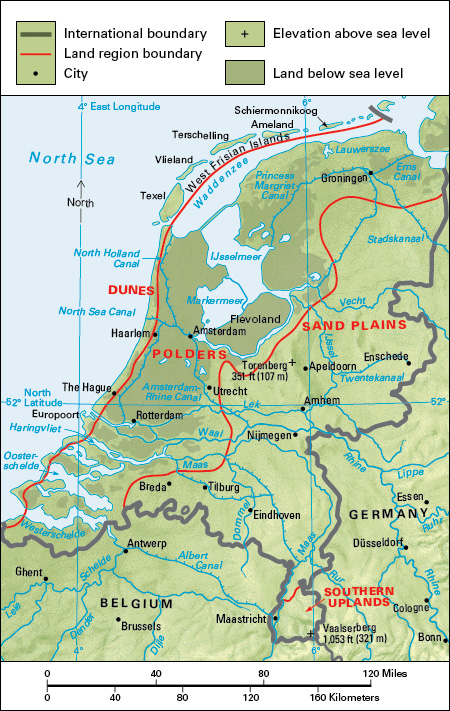
The Polders
lie mostly below sea level and are protected from the sea by the sand dunes or by dikes. The Prins Alexander Polder, the lowest point in the Netherlands, is near Rotterdam. It lies 22 feet (6.7 meters) below sea level. The Polders region forms over two-fifths of the country. It consists of flat, fertile areas of clay soils that were once covered by seas, swamps, or lakes. It has some of the country’s most productive farmlands and largest cities. 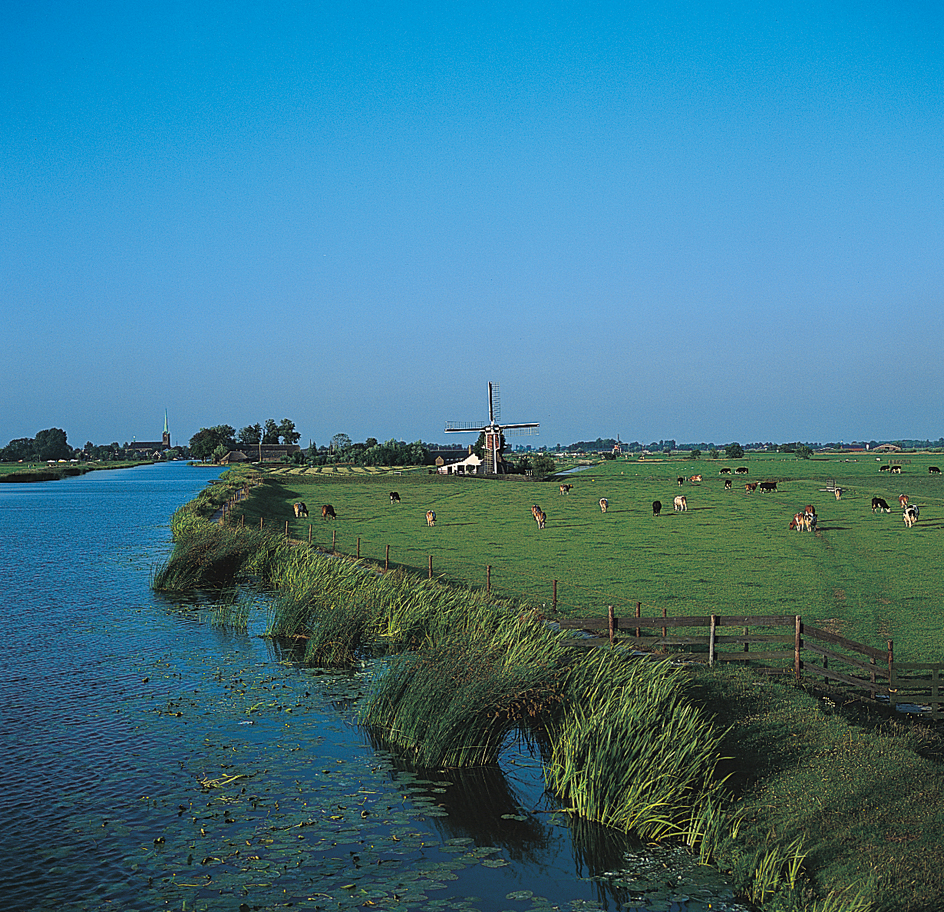
Much of the southern part of the Polders consists of marshy islands and peninsulas that make up a delta. The delta is formed by the Maas << mahs >> and Schelde << SKEHL duh >> rivers and branches of the Rhine River. Massive dams prevent the sea from flooding the region. One of the dams has huge floodgates that allow salt water and natural tides to enter the protected area. This preserves the natural environment and the fishing economy of the region. During storms, the floodgates can be closed.
The Sand Plains
lie less than 100 feet (30 meters) above sea level in most places. In the southwest, the region rises higher. Low, sandy ridges cross the plains and create a rolling landscape. Orchards in the east produce fruit. Forests cover much of the region. A broad valley of clay soils lies along the banks of the Maas, called the Meuse in French, and along the branches of the Rhine. These rivers and the canals that connect them with other rivers form an important transportation network.
The Southern Uplands
form the highest land region. The highest point, Vaalserberg << VAHL suhr behrk >>, rises 1,053 feet (321 meters) near Maastricht << MAHS trihkt >>. The region has naturally fertile soils.
Climate
The Netherlands has a mild, damp climate. It has gentle winters and moderately warm summers. The sky is frequently overcast in winter, and fog often covers the land. Temperatures average from 60 to 65 °F (16 to 18 °C) in summer, and a little above 30 °F (–1 °C) in winter. Extremely hot or cold temperatures are rare.
The Netherlands is small in area, and there are no great differences of climate from region to region. Most areas of the country receive about 25 to 30 inches (63 to 76 centimeters) of precipitation (rain, melted snow, and other forms of moisture) in a year. Summer is the wettest season, but precipitation is fairly evenly distributed throughout the year. The Dutch weather is changeable, and showers may fall unexpectedly.
Floods threaten the Netherlands from two directions. North Sea storms pound against the coastal dunes and sea dikes. And rain-swollen rivers, especially the Maas and the Rhine, press against the river dikes. Dike breaks in the past have resulted in many floods, sometimes with great loss of life. For example, a massive flood along the North Sea coast in 1953 caused about 1,800 deaths. The country is so low-lying that it would be flooded if global warming melted polar ice and raised the sea level.
Economy
The economy of the Netherlands is technically advanced and highly industrialized. Because the country has few natural resources, it depends heavily on foreign trade. Industries import most raw materials and export finished products. Modern farming techniques have made the small amount of farmland highly productive.

Service industries,
taken together, account for about 80 percent of the country’s gross domestic product (GDP)—the total value of goods and services produced within the country in a year. They also account for about 85 percent of the country’s total employment. Finance, insurance, real estate, and business services provide about 30 percent of the country’s GDP—much more than any other industry group. Hotels, restaurants, and shops benefit from the millions of tourists who visit the Netherlands each year from Belgium, Germany, the United Kingdom, and other countries.
Manufacturing
accounts for about an eighth of the GDP and employs about a tenth of the country’s workers. Several large international manufacturers have headquarters in the Netherlands. Royal Philips, one of the world’s largest health technology companies, has its headquarters in Amsterdam. Other manufacturers produce automobiles and trucks, industrial machinery, and steel.
Food processing is a major manufacturing industry. Dairy products are the chief food products. The Netherlands is one of the world’s major cheese manufacturers. Other Dutch food products include beer, chocolate, processed meats, and sugar.
The chemical and petroleum industries are also important to the nation’s economy. Rotterdam is the site of a huge complex of chemical plants and oil refineries. Amsterdam has long been a famous center of diamond cutting and polishing. Delft is known for producing earthenware pottery called delftware.
Agriculture.
Because land is scarce, Dutch farmers work to make their soil as productive as possible. By fertilizing the soil heavily and using modern equipment, Dutch farmers have become specialized producers of products sold throughout the world. The value of agricultural exports is larger than the value of agricultural imports. 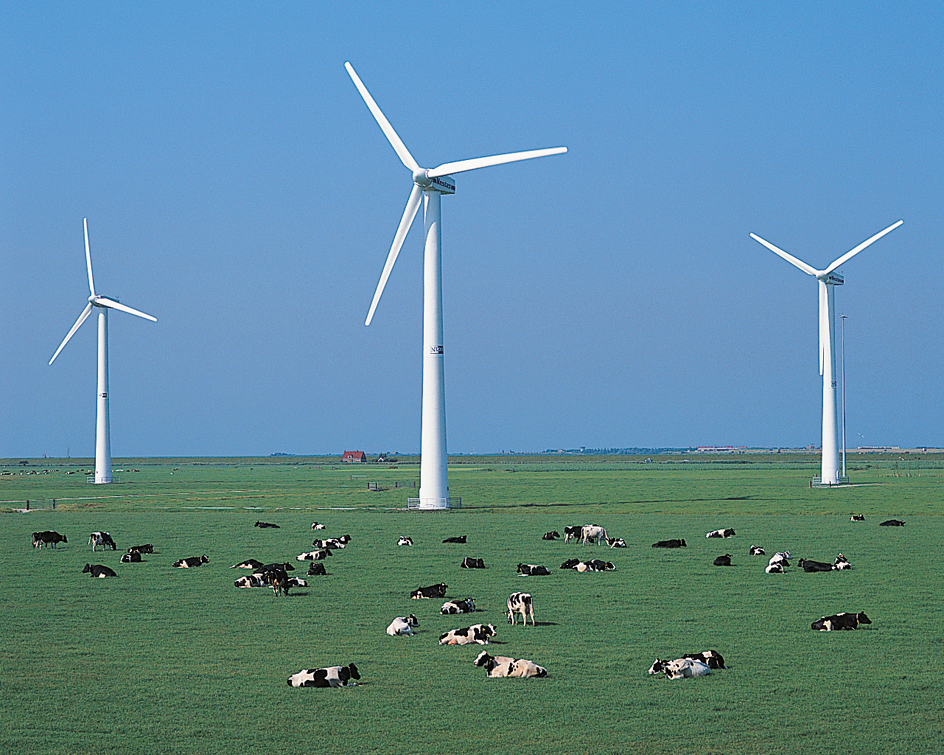
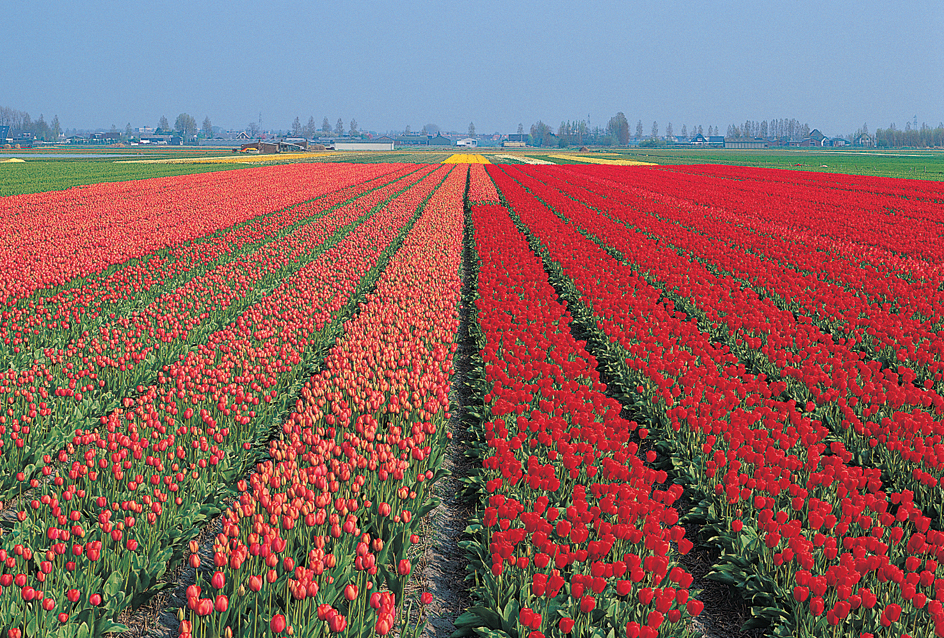
About half of the country’s total land area is farmland. Dairy farming is the most important branch of agriculture. Most dairy farmers also raise crops, mainly to feed their livestock. Dutch farmers also raise beef cattle, chickens, goats, hogs, sheep, and turkeys.
The country’s principal crops include mushrooms, onions, potatoes, sugar beets, tomatoes, and wheat. An important specialty of Dutch agriculture is horticulture. Flowers and vegetables are grown in enormous greenhouses. They are trucked to neighboring countries, and fresh flowers are flown to most parts of the world. Flower bulbs, especially tulip bulbs, are also important.
Mining.
The Netherlands has large deposits of natural gas and some petroleum. One of the world’s largest natural gas fields lies near Slochteren << SLOK tuh ruhn >>, in the northeastern province of Groningen << GROH nihng uhn >>. Oil wells operate offshore in the North Sea.
Fishing.
The fish catch comes mainly from coastal waters and inlets, and from the North Sea. The major catches include herring, mackerel, plaice, sardines, shrimp, sole, and whiting.
Energy sources.
The Netherlands is a major producer of natural gas. But its oil wells supply only a small part of its petroleum needs. Natural gas provides much of the country’s energy. Coal, hydroelectric power, nuclear power, and petroleum provide most of the rest.
International trade.
The Netherlands relies heavily on foreign trade because it has few natural resources. Its chief trading partner is Germany. Other important trading partners are Belgium, China, France, Italy, Spain, the United Kingdom, and the United States. The Netherlands exports more goods to other European Union countries than it imports. It imports more from the United States and Asian countries than it exports. 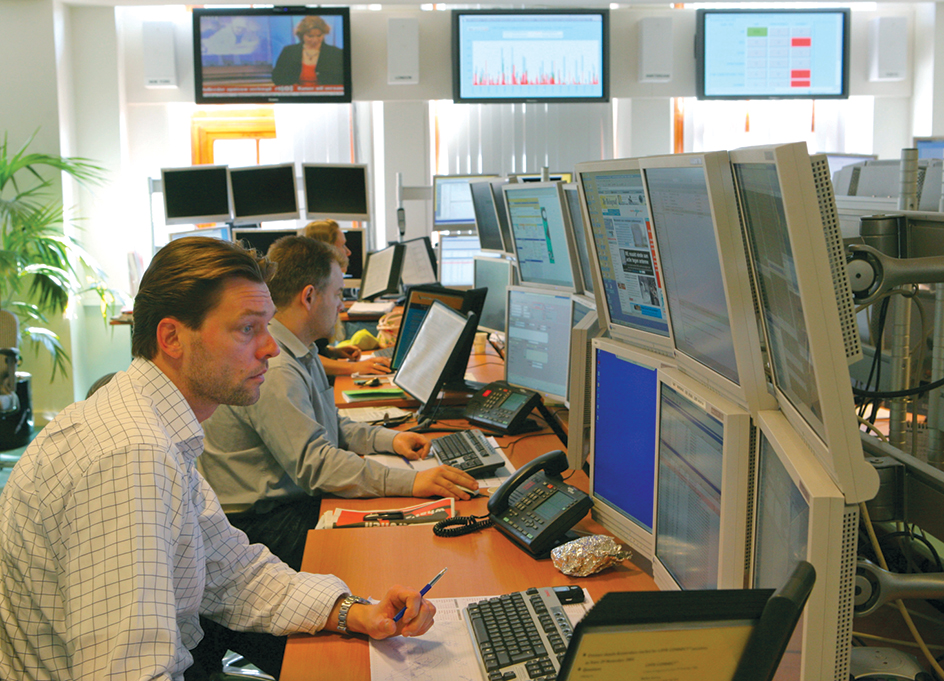
The main imports of the Netherlands include automobiles, chemicals, clothing, electronic equipment, food, iron and steel, machinery, paper and paper products, petroleum, and plastics. Among the exports are chemicals, dairy products, electronic equipment, flowers, meat, motor vehicles, natural gas, petroleum, and vegetables.
Transportation.
The Netherlands has an extensive network of navigable rivers and canals. The main rivers and many of the canals are important waterways. Barges on these waterways carry a great deal of the country’s freight. The country’s railroad system provides fast and frequent service.
The Netherlands has an excellent network of paved roads. Almost all Dutch families own an automobile, and most people have a bicycle. The bicycle remains important for transportation as well as recreation. Bike paths are found throughout the country. Motor-driven bicycles called bromfietsen << BROM feet suhn >>, which literally means roar bikes, are common.
Rotterdam is one of the busiest seaports in the world. It serves as a gateway to and from much of Europe by way of the Rhine River, one of Europe’s busiest inland waterways. Amsterdam, the second largest port in the Netherlands, is linked to the North Sea by the North Sea Canal, one of the world’s deepest and widest artificial waterways. The canal is about 50 feet (15 meters) deep and 525 feet (160 meters) wide. 
The country’s most important airport, Schiphol << SKIHP hohl >>, near Amsterdam, is one of the busiest airports in Europe. KLM Royal Dutch Airlines has headquarters there. Established in 1919, KLM (now part of Air France-KLM) is the oldest airline in the world still in operation.
Communication.
The Netherlands has many national and regional daily newspapers. The largest paper is De Telegraaf, published in Amsterdam and sold throughout the country.
Traditionally, private broadcasting companies have prepared most programs for the radio and television networks. Most of these companies represent political, religious, or cultural groups. In the late 1900’s, commercial broadcasting emerged to supplement the traditional private programming. In addition, cable television opened the country to a wide variety of foreign and commercial programs. The country also has public radio and television stations.
History
Early days.
In the 50’s B.C., Roman soldiers under Julius Caesar invaded what are now the Netherlands, Belgium, and Luxembourg. The Romans conquered much of the region, now called the Low Countries. The word Netherlands means Low Countries, but the Low Countries also include Belgium and Luxembourg.
In the A.D. 400’s, a Germanic people called the Franks drove the Romans out of the Low Countries. The Frankish kingdom broke apart during the 800’s. In 870, the Low Countries were divided between the East and West Frankish kingdoms (later Germany and France). The area that is now the Netherlands became part of the East Frankish kingdom.
The rise of commerce.
Local dukes, counts, and bishops became increasingly powerful as the region developed. During the 1100’s, trade and industry began to expand rapidly in the Low Countries. Fishing, shipbuilding, shipping, and textile manufacturing became especially important. Towns began to develop and grow.
Spanish control.
Beginning in the 1300’s, the French dukes of Burgundy won control of most of the Low Countries through inheritance, marriage, purchase, and war. The marriage of Mary of Burgundy to Maximilian of the House of Habsburg in 1477 joined the Low Countries with the Habsburg empire. In 1516, Mary and Maximilian’s grandson Charles inherited the kingdom of Spain, putting the Low Countries under Spanish control. In 1519, Charles also became Archduke of Austria and Holy Roman Emperor Charles V.
Eighty Years’ War.
During the early 1500’s, a Protestant movement called the Reformation spread through the Low Countries. Charles tried to stop this threat to Roman Catholicism by persecuting Protestants. Charles gave up rule of the Low Countries and of Spain, in 1555 and 1556, to his son, Philip II. Philip stepped up the struggle against Protestants and tried to take complete power over the Low Countries. In 1566, the people began to rebel. In 1568, William I (called the Silent), prince of Orange, led the nobles in revolt.
The Spanish troops were generally successful in land battles, but the rebels’ ships controlled the sea. The Spaniards attacked Leiden in 1573, but the city held out bravely. In 1574, the people opened dikes that held back the sea, and a Dutch fleet sailed over the floodwaters to rescue Leiden from the Spaniards.
By 1579, the revolt had started to break apart. The southern provinces of the Low Countries (now Belgium) returned to Spanish control. Protestantism became stronger in the northern provinces (now the Netherlands). In 1579, most northern provinces formed the Union of Utrecht and pledged to continue the revolt.
On July 26, 1581, the northern provinces declared their independence from Spain, beginning what later became known as the Dutch Republic or the Netherlands. The Dutch fought for their freedom until 1648, except for a temporary peace from 1609 to 1621. Spain finally recognized Dutch independence in 1648.
Prosperity and power.
The 1600’s were the Golden Age of the Netherlands. The country became the leading sea power. Its merchant fleet tripled in size between 1600 and 1650, and the Dutch accounted for about half of Europe’s shipping. Dutch explorers, including Willem Barents << VIHL uhm BAHR uhnts >> and Abel Janszoon Tasman << AH buhl YAHN sohn TAZ muhn >>, found new sea routes and fisheries. Amsterdam became a great trading center of Europe. Dutch banks and businesses thrived. The Golden Age also brought major cultural achievements, especially in painting. 
During the Golden Age, the Dutch Republic developed a great colonial empire in many parts of the world. In 1602, Dutch firms trading with the East Indies combined to form the Dutch East India Company. The company founded Batavia (now Jakarta, the capital of Indonesia) as its headquarters. The company’s forces largely drove the British and Portuguese out of what later became the Netherlands Indies (now Indonesia). The company also took control of Ceylon (now Sri Lanka) and colonized the southern tip of Africa. From the mid-1600’s to the mid-1800’s, the Dutch were the only Westerners allowed to trade with Japan.
The Dutch West India Company was founded in 1621 to trade in the New World and western Africa. In 1624, the company colonized New Netherland, which consisted of parts of present-day New York, New Jersey, Connecticut, and Delaware. In 1626, the colony’s governor, Peter Minuit, bought Manhattan Island from the Indians for goods worth about $24. Dutch colonists had established New Amsterdam (now New York City) there the year before. From 1630 to 1654, the Dutch controlled Brazil. During that time, the Dutch also acquired a number of islands in the Caribbean, including Aruba, Curaçao, and Saint Martin (spelled Sint Maarten in Dutch).
Wars with England and France.
The Netherlands fought three naval wars with England from 1652 to 1674. The English hoped to seize the shipping and trading leadership from the Dutch, but they failed. During this period, the Dutch won what is now Suriname from the English, and the English gained New Netherland.
France and England formed a secret alliance against the Dutch Republic in 1670 and attacked it in 1672. The Dutch fleet prevented the English from landing by sea, but French troops seized a number of Dutch towns. William III, prince of Orange, was then elected stadholder (governor). He stopped the French by opening some dikes and flooding the land. Spanish and German troops also helped the Dutch. The English suffered major defeats at sea, and they made peace with the Dutch in 1674. The French were driven out, and they signed a peace treaty in 1678.
William’s wife, Mary, was a member of the English royal family. In 1688, in what is called the Glorious Revolution, English leaders asked William to lead an invasion to the overthrow the English king James II. In 1689, William and Mary became joint monarchs of England as William III and Mary II. The Netherlands, England, and other European countries battled France in two more wars, fought from 1689 to 1697 and from 1701 to 1714.
The 1700’s.
The long wars against France exhausted the Netherlands. Dutch industry and trade began to falter, and the Netherlands entered a period of economic decline.
During the Revolutionary War in America (1775-1783), the Dutch aided the Americans against the British. The United Kingdom started a naval war against the Dutch in 1780. The Dutch were severely defeated by 1784.
In 1795, the weakened Netherlands fell to invading French troops. The Dutch supporters of the French renamed the country the Batavian Republic and set up a new government. The United Kingdom seized most of the Dutch overseas possessions.
Independence.
In 1806, Napoleon I of France forced the Dutch to accept his brother Louis as their king. The Batavian Republic became the Kingdom of Holland. Napoleon wanted tighter control over the country and made it part of France in 1810. The Dutch drove out the French in 1813.
In 1814 and 1815, Europe’s political leaders remapped much of the continent at a series of meetings called the Congress of Vienna. They united Belgium, Holland, and Luxembourg into the Kingdom of the Netherlands to limit the power of France. William VI, prince of Orange, became King William I of the Netherlands and Grand Duke of Luxembourg.
The customs, economies, languages, and religions of the Dutch and the Belgians differed greatly. The majority of Belgians were Roman Catholics, and the upper classes spoke French. In 1830, Belgium declared its independence from the Kingdom of the Netherlands.
Luxembourg ended its political ties with the Dutch royal family in 1890. That year, 10-year-old Wilhelmina had become queen after the death of her father, William III. But Luxembourg’s laws did not permit a female ruler.
The Netherlands stayed neutral during World War I (1914-1918). But the naval operations of the warring countries interfered with Dutch shipping and trading.
World War II.
On May 10, 1940, during World War II, German troops invaded the Netherlands. Four days later, German bombers destroyed much of Rotterdam. The Dutch army surrendered. Most of the Dutch navy escaped capture and supported the Allies, the countries opposing Germany and its partners.
During the German occupation, from 1940 to 1945, the Dutch suffered greatly. The Germans killed about 75 percent of the nation’s Jews—about 104,000 people—mostly in death camps. They also forced thousands of other Netherlanders to work in German factories. The Dutch resistance movement secretly published newspapers, hid Jews from capture, and committed acts of sabotage against the Germans. By the time Germany surrendered to the Allies in May 1945, about 250,000 Netherlanders had been killed or had starved to death.
The Netherlands was also involved in the war in the Pacific Ocean. In March 1942, the Netherlands Indies (now Indonesia) fell to Germany’s ally Japan after the defeat of the Dutch fleet. The tens of thousands of Dutch then residing in the Indies became prisoners in Japanese camps.
Economic recovery.
World War II left much of the Netherlands in ruins. Many of the nation’s factories, bridges, and railroad lines had been destroyed. The great harbor at Rotterdam was crippled. Much of the land was flooded as a result of damage to the dikes. 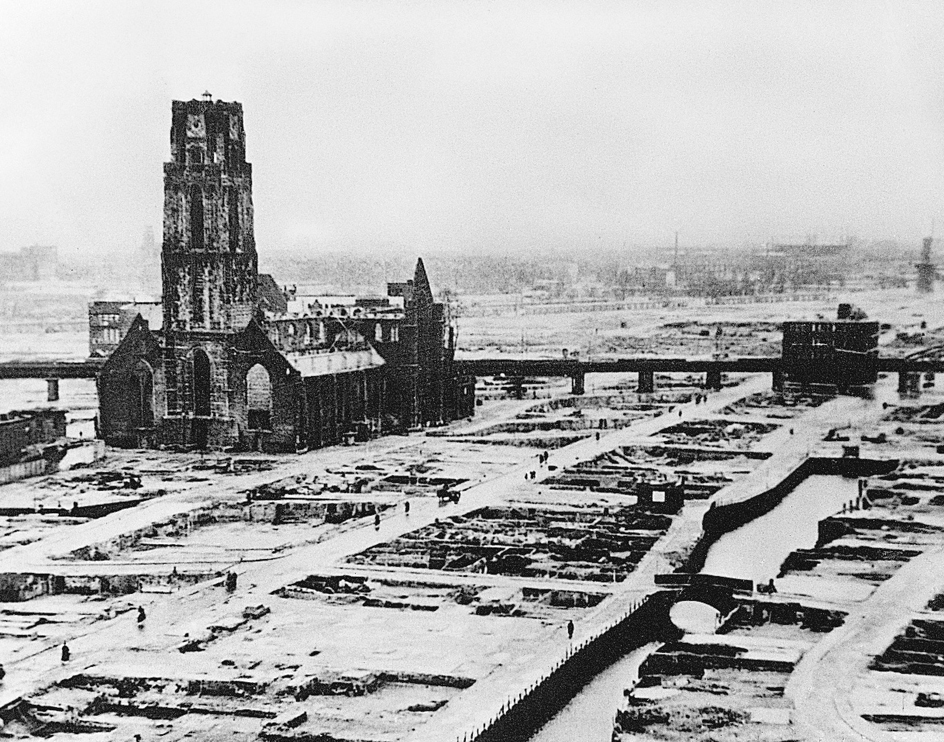
After the war, the Dutch dedicated themselves to rebuilding their country, and the government supported close international cooperation to achieve this goal. In 1945, the Netherlands became a charter member of the United Nations (UN). In 1948, the Netherlands joined with Belgium and Luxembourg to eliminate all tariffs on trade among themselves, forming an organization called Benelux. In 1949, the Netherlands became part of the North Atlantic Treaty Organization (NATO), a defense alliance of European and North American nations.
In the 1950’s, the Netherlands helped form the European Coal and Steel Community, the European Atomic Energy Community (Euratom), and the European Economic Community. These agencies later became the basis for the European Union, which works for economic and political cooperation among its members.
By 1955, Dutch industrial production had increased about 60 percent over the pre-World War II level. Farm output was almost 20 percent greater.
Political changes.
In 1948, the aging Queen Wilhelmina gave up the throne to her daughter, Juliana. At that time, a revolt was underway in the Netherlands Indies. The fighting, which had started in 1945, continued until 1949, when the Netherlands recognized the independence of Indonesia. In 1954, Suriname and the Netherlands Antilles, which included six Caribbean islands, were made self-governing and equal members of the Dutch kingdom. In 1962, the Dutch gave up their last colony, West New Guinea (now the Papua region of Indonesia), to UN control. The UN turned the region over to Indonesia in 1963.
In 1980, Juliana gave up the throne at the age of 71. Her oldest daughter, Beatrix, became queen.
Economic development.
By the late 1900’s, the Netherlands had achieved a high standard of living. Economic cooperation, both with other countries and at home, helped the Dutch to reestablish much of their prosperity after World War II. During the late 1940’s and the 1950’s, Dutch industry, labor, and government worked together to avoid strikes and expand industry. The discovery of a natural gas field in the northern part of the country in 1959 also provided the Netherlands with a great economic boost. And Rotterdam, heavily damaged during the war, was rebuilt. 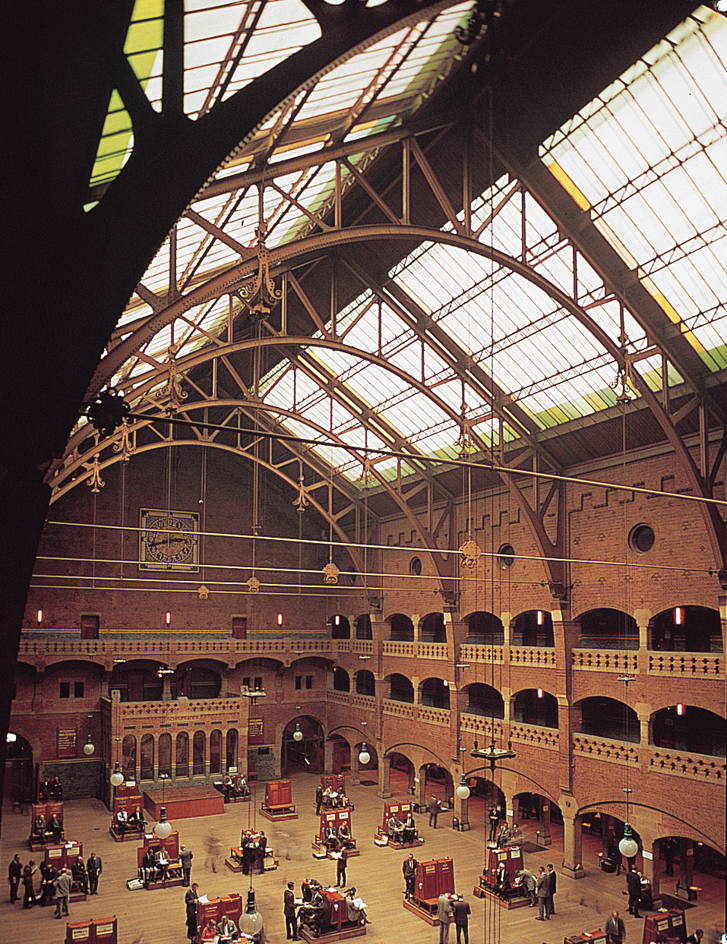
Immigration.
In the late 1900’s, hundreds of thousands of people from former Dutch colonies and from Mediterranean countries moved to the Netherlands. Many of the immigrants came from Indonesia. In the 1970’s, people from the Molucca Islands demanded that the Dutch government take steps to free their homeland from Indonesian control. Some Moluccans in the Netherlands staged terrorist acts to dramatize their demands.
In 1975, Suriname left the Kingdom of the Netherlands and became a fully independent nation. Many people from Suriname moved to the Netherlands shortly before independence.
Liberal Dutch laws granting political asylum (shelter and protection) attracted refugees from around the world. Immigrants from Turkey, Morocco, and many other countries also came. By the 1990’s, many Dutch people wanted to slow the pace of immigration. As a result, the government tightened the country’s immigration laws, and some politicians adopted anti-immigrant platforms.
Recent developments.
In 1992, the Netherlands signed the Treaty on European Union, also called the Maastricht Treaty for the Dutch city where it was signed. This treaty established the European Union (EU) and called for a single European currency, the euro. In 1999, the Netherlands and most other EU countries officially adopted the euro. Euro notes and coins replaced the notes and coins of the traditional Dutch currency, the guilder, in 2002. 
Jan Peter Balkenende of the Christian Democratic Appeal (CDA) party was prime minister at the head of coalition governments from 2002 until his government collapsed in February 2010. Balkenende remained prime minister until a new coalition government formed in October. Mark Rutte of the People’s Party for Freedom and Democracy became prime minister. Also in 2010, the Netherlands Antilles broke apart into separate political units, including the self-governing territories of Curaçao and St. Maarten.
In April 2012, Rutte, troubled by a worsening budget crisis, resigned from office. He remained, however, as caretaker prime minister until September elections returned his party to power. Rutte became the head of a new coalition government in November.
In 2013, Queen Beatrix gave up the throne at the age of 75. Her oldest son, Willem-Alexander, became king. In elections held in 2017, the People’s Party for Freedom and Democracy retained power and Rutte remained as prime minister.
Beginning in 2020, the Netherlands faced a public health crisis as a result of the COVID-19 pandemic (global epidemic). In March, Dutch authorities shut schools, canceled large gatherings, and ordered some businesses to close in order to slow the spread of the disease. Later in the year, and through 2021, restrictions were lifted or reissued based on rates of infection and hospitalization. In January 2021, demonstrators protested the implementation of nightly curfews. In Amsterdam, Rotterdam, and several other cities, a number of protests became violent and destructive.
The distribution of COVID-19 vaccines became the major focus of government public health efforts in 2021. Vaccination rates increased during the spring and summer, contributing to lower rates of infection. In late 2021 and early 2022, however, the spread of new variants of the disease contributed to rising infection and hospitalization rates. Most of the severe cases occurred among unvaccinated people. By early 2023, nearly 9 million COVID-19 cases had been recorded in the Netherlands, and more than 20,000 Dutch people had died from the disease.
In January 2021, Rutte announced that he and his Cabinet were resigning after it was revealed that the government had falsely accused thousands of families of welfare fraud. Rutte and his ministers remained in office as a caretaker government, however. In March, Rutte’s party again won the most votes in parliamentary elections. Rutte’s efforts to form a new coalition continued until December, when he announced that his People’s Party for Freedom and Democracy had reached a governing agreement with three other parties. In July 2023, Rutte announced the resignation of his Cabinet yet again after coalition partners were unable to reach an agreement on immigration policy. Rutte remained as caretaker prime minister. Conservative parties made gains in elections held in late 2023. In July 2024, former intelligence chief Dick Schoof became prime minister of a new conservative coalition government.
